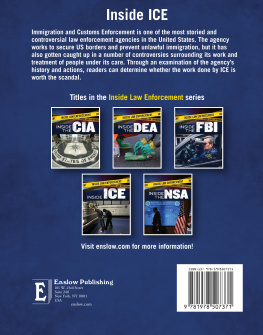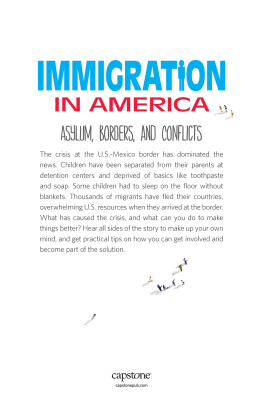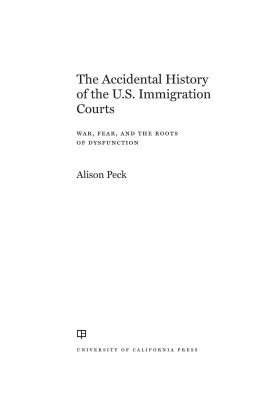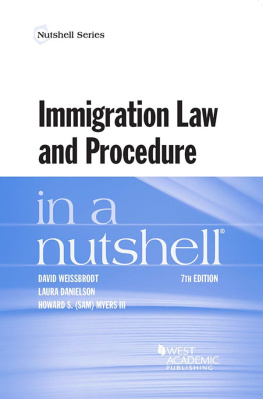
Published in 2020 by Enslow Publishing, LLC
101 W. 23rd Street, Suite 240, New York, NY 10011
Copyright 2020 by Enslow Publishing, LLC.
All rights reserved.
No part of this book may be reproduced by any means without the written permission of the publisher.
Library of Congress Cataloging-in-Publication Data
Names: Sampathkumar, Mythili, author.
Title: Inside ICE / Mythili Sampathkumar.
Description: New York: Enslow Publishing, 2020. | Series: Inside law enforcement | Includes bibliographical references and index. | Audience: Grade 5 to 8.
Identifiers: LCCN 2018058099| ISBN 9781978507371 (library bound) | ISBN 781978508491 (pbk.)
Subjects: LCSH: U.S. Immigration and Customs EnforcementJuvenile literature. | Illegal
aliensGovernment policyUnited States. | United StatesEmigration and immigration Government policyJuvenile literature.
Classification: LCC JV6483 .S26 2020 | DDC 363.25/9370973dc23
LC record available at https://lccn.loc.gov/2018058099
Printed in the United States of America
To Our Readers: We have done our best to make sure all website addresses in this book were active and appropriate when we went to press. However, the author and the publisher have no control over and assume no liability for the material available on those websites or on any websites they may link to. Any comments or suggestions can be sent by email to .
Photo Credits: Cover, pp. Wichita Eagle/Tribune News Service/Getty Images.
CONTENTS
INTRODUCTION
T he Immigration and Customs Enforcement (ICE) agency was formed in 2003 by President George W. Bush as part of the effort to combine and consolidate several border protection, immigration, and port security services into one agency. It was formed by combining several functions from the previous Immigration and Naturalization Service (INS) and US Customs Service agencies under one roof. As a result, it is the second largest agency under its parent, the Department of Homeland Security (DHS).
ICE has been given a fairly broad range of powersfrom enforcing US immigration laws and customs rules to investigating terrorist activity. Those main tasks are reflected in the two overarching divisions of the federal agency, which are Homeland Security Investigations (HSI) and Enforcement and Removal Operations (ERO). However, the agency often gets confused with US Border Patrol, which is actually run through ICEs sister agency under the DHS, US Customs and Border Protection (CBP). The two agencies perform separate functions, and this book will describe in more detail ICEs tasks, such as immigration and naturalization services, border protection, port security, customs and duties management, and counterterrorism operations.
ICE is the second largest contributor to the Joint Terrorism Task Force, a partnership of several federal, state, and local law enforcement agencies set up to help coordinate and combine efforts to fight terrorism. The agency employs approximately twenty thousand people in four.

ICE has come under fire in recent years for its treatment of immigrants and refugees, leading to protests of its actions and the agency as a whole.
Although ICE has only been around since 2003, it has been no stranger to political debates and controversies. Most notably, critics have called for the abolishment of the agency over issues like family separation in the summer of 2018, when the agency was tasked with separating children from parents and guardians as they entered the country illegally at the US-Mexico border.
The acting director in 2018 was Ronald Vitiello, who was appointed to the position by President Donald Trump on June 30, 2018. He previously served as the acting deputy commissioner of the CBP and chief of the US Border Patrol. Vitiello reported to the secretary of DHS, Kirstjen Nielsen.
Throughout this book, youll learn about the short but storied history of this unique law enforcement agency, how and why ICE officers do their work, and how people across the country and around the world have responded to the agencys actions.
CHAPTER 1
THE HISTORY
OF ICE
O n September 11, 2001, four passenger flights traveling from the northeast United States to California were hijacked by nineteen individuals affiliated with the terrorist group al-Qaeda. The terrorists purposely crashed two planes into the Twin Towers of the World Trade Center in New York City, and one plane crashed into the Department of Defense headquarters at the Pentagon near Washington, DC. The fourth plane landed in a field in Shanksville, Pennsylvania, after passengers on board fought the hijackers for control of the plane.
The terrorist attacks of September 11, 2001, resulted in nearly three thousand people dying and more than six thousand injured. It also made the country take a harder look at immigration because the terrorists involved had entered, lived, and gone to flight school in the United States ahead of the tragic events.

The terrorist attacks on the World Trade Center in New York City on September 11, 2001, led to the creation of ICE.
Americas New Security Measures
Congress passedand President George W. Bush signed into law the Homeland Security Act in November 2002, dissolving the former Immigration and Naturalization Service, the US Customs Service, and the Federal Protective Service and replacing them with several new agencies under the umbrella of the Department of Homeland Security, which was tasked with protecting the country from another potential act of terrorism.
The DHS secretary became a cabinet-level position in the Bush administration and oversees twenty-four sub-agencies, including the Coast Guard and Secret Service. It was the single largest government reorganization since the country created the Department of Defense on September 18, 1947, in the wake of World War II.
THE AFTERMATH OF 9/11
The 9/11 terrorist attacks killed nearly three thousand people from the United States and ninety other countries, injured more than six thousand, and prompted the country and the administration of President George W. Bush to take a hard look at the immigration policies that allowed the terrorists to enter, live in, and go to flight school in America. The attacks also led to the US war in Afghanistan, where it was thought the mastermind of the attacks, Osama bin Laden, had been hiding. Under President Barack Obama, bin Laden was killed in 2011 in Pakistan, but the US war in Afghanistan continued against various terrorist groups that reside in the country.

Osama bin Laden was behind the 9/11 attacks on America, which led to the creation of ICE.
One of the new agencies created under the Homeland Security Act was the Bureau of Border Security, which was renamed Immigration and Customs Enforcement (ICE) and began operating in March 2003. INS functions were thus split between ICE, the new US Citizenship and Immigration Services (USCIS), and the Transportation Security Administration (TSA), also known as airport security. There was also a sister agency created under DHS, US Customs and Border Protection (CBP). The shift and creation of agencies was a chaotic but fairly quick move, and it changed forever how America enforced immigration laws and how citizens traveled and dealt with the threat of terrorism.
Next page











